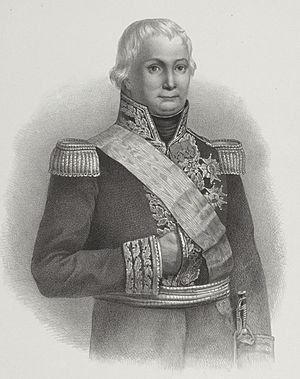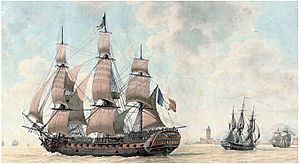Honoré Joseph Antoine Ganteaume facts for kids
Quick facts for kids
Count
Honoré Joseph Antoine Ganteaume
|
|
|---|---|
 |
|
| Born | 13 April 1755 La Ciotat |
| Died | 28 July 1818 (aged 63) Aubagne |
| Allegiance | |
| Service/ |
French Navy |
| Rank | Vice Admiral |
| Battles/wars |
|
Count Honoré Joseph Antoine Ganteaume (born 13 April 1755 in La Ciotat – died 28 July 1818 in Aubagne) was an important officer in the French Navy. He rose to become a Vice-Admiral.
Ganteaume began his career sailing on merchant ships. Later, he joined the navy and fought in the American Revolutionary War. He served under famous admirals like d'Estaing and Suffren.
During the French Revolutionary Wars, he commanded a large warship called Trente-et-un Mai. He took part in major battles, including the Glorious First of June. He also survived the Battle of the Nile in Egypt, where he was injured.
After the Battle of the Nile, Ganteaume became friends with General Bonaparte. Bonaparte helped him get promoted to Rear-Admiral. Ganteaume was then given command of a fleet to help the French army in Egypt. However, his missions in Ganteaume's expeditions of 1801 were very difficult. He spent months trying to avoid the British Navy and eventually could not complete his task.
He also helped supply French forces in the Saint-Domingue expedition. Later, during the Napoleonic Wars, he was supposed to join other French fleets in the Caribbean. But British ships blocked him, and he could not leave port. Ganteaume held several important positions in the French Empire. When the king returned to power, Ganteaume supported him.
Contents
Honoré Joseph Antoine Ganteaume was born in La Ciotat, a town known for its sailors. His family had many merchant sailors. He started sailing at just 14 years old on a merchant ship led by his own father. By the time he was 22, Ganteaume had already completed five long trips to the Middle East and two to the Caribbean. He gained a lot of experience on a large merchant ship called Fier Rodrigue.
In 1778, France joined the American Revolutionary War. Ganteaume decided to join the French Royal Navy as an auxiliary officer. His ship, Fier Rodrigue, was bought by the navy and turned into a 54-gun warship. This ship helped protect convoys (groups of ships) heading to America. It was part of Admiral d'Estaing's fleet.
Fighting in the American War of Independence
While serving with Admiral d'Estaing, Ganteaume fought in the Capture of Grenada. He also took part in the Siege of Savannah. In 1781, he was promoted to auxiliary Frigate Lieutenant. He was given command of a supply ship called Marlborough. This ship was part of a convoy going to the Indies, protected by Admiral Suffren.
From 1781 to 1785, Ganteaume served on the frigate Surveillante. He continued to rise through the ranks. He became a Fireship Captain in 1784 and a sub-Lieutenant in 1786.
After the war ended, Ganteaume returned to working for the Mississippi Company. He commanded several merchant ships, traveling to China and the Indies. In 1793, British forces captured him on a merchant ship and put him in prison. After his release, he rejoined the Navy as a Lieutenant. He served on the 74-gun warship Jupiter in the Atlantic Ocean.
Commanding the Trente-et-un Mai
In 1794, Ganteaume was promoted to Captain. He was given command of the 74-gun ship Trente-et-un Mai. During the Atlantic campaign of May 1794, he tried to join the main French fleet. He arrived late for the Glorious First of June battle. However, he still took part in the final moments of the fight and was wounded three times.
In the winter, Ganteaume led Trente-et-un Mai in a difficult winter cruise called the Croisière du Grand Hiver. During this time, he bravely rescued the crew of another damaged French ship, Scipion.
In 1795, Trente-et-un Mai sailed to the Mediterranean Sea. It fought a two-hour battle against a Spanish warship. On 18 April 1795, the ship was renamed Républicain. It then joined a fleet under Vice-Admiral Martin and fought in the Battle of Hyères Islands.
Later in 1795, Ganteaume was put in charge of a small fleet for an expedition to Smyrna (modern-day İzmir, Turkey). He successfully broke a British blockade there. He also captured a British frigate called HMS Nemesis.
In 1796, Ganteaume returned to the Atlantic. He successfully managed to get past the British blockade of Brest. He brought a convoy carrying important supplies into the harbor.
Adventures in Egypt
Ganteaume became the Chief of Staff to Rear-Admiral Bruix. He took part in the French campaign in Egypt and Syria. He was on the flagship, Orient. He fought in the Battle of the Nile, where he was wounded. He barely escaped death when he left the burning Orient on a small boat. The Orient exploded shortly after he got off.
General Bonaparte asked for Ganteaume to be promoted. So, Ganteaume became a Rear-Admiral. He then led a group of small ships on the Nile River. He helped in the Siege of Jaffa, the Siege of Acre, and the Battle of Abukir.
On 22 August 1799, Ganteaume left Alexandria with two frigates and other small ships. His mission was to take General Bonaparte back to France. Bonaparte ordered the ships to sail close to the African coast to avoid British ships. They landed in Corsica and finally arrived in Fréjus, France, on 2 October.
After returning to France, Bonaparte became the First Consul. He appointed Ganteaume to the Council of State, where he led the Navy section.
Ganteaume's Expeditions of 1801
In 1801, Ganteaume was given command of a fleet of seven ships in Brest. His job was to deliver supplies and 5,000 soldiers to the French Army in Egypt. He successfully sailed past British-held Gibraltar. For six months, Ganteaume sailed around the Mediterranean Sea, trying to avoid the British fleet.
Ganteaume had to return to Toulon to resupply and repair his ships. In the next few months, he tried three more times to reach Egypt. Once, he even got close to Alexandria. But when he finally arrived near Egypt, in June 1801, the troops could not land. The local people were unfriendly, and there was a strong British naval threat.
Ganteaume eventually gave up on his mission. He returned to Toulon. On his way back, he captured Elba and four British ships. These included the frigate HMS Success and, in the action of 24 June 1801, the 74-gun HMS Swiftsure. However, he failed his main mission to supply the French armies in the Middle East.
Ganteaume's many changes of plan led to a funny poem:
|
Vaisseaux lestés, tête sans lest, |
Loaded ships, head without weight, |
Later Years and Important Roles
After the Treaty of Lunéville ended a war in 1801, Ganteaume was asked to support French forces in the Saint-Domingue expedition. In 1802, he became the Maritime Prefect for Toulon, meaning he was in charge of the navy in that area.
When another war started in 1803, and Napoleon became Emperor in 1804, Ganteaume was promoted again. He became a Vice-Admiral and a Count of the Empire. He was put in command of the fleet in Brest.
In 1805, during the Trafalgar Campaign, Napoleon thought about sending Ganteaume to Ireland with a large army. This was similar to an earlier attempt in 1796. Instead, Ganteaume was ordered to go to the Caribbean. He was supposed to bring reinforcements and then return to Europe with other French fleets.
Bad weather stopped Ganteaume from leaving Brest. He finally left a month later. On his journey, he met the British Channel Fleet and had to retreat back to Brest. There, the British completely blocked him in. Ganteaume was ordered to break through the blockade and join another French admiral, Villeneuve. However, Villeneuve's decision to go to Cadiz ruined this plan.
Final Years of Service
In 1808, Ganteaume took command of French fleets in Toulon and Rochefort. His goal was to deliver supplies to Corfu, which was being blocked by the British. He successfully escorted his convoy to Corfu and returned to Toulon. The next year, he allowed two frigates to chase a British ship, HMS Proserpine. They captured it and brought it to Toulon.
In June 1808, Ganteaume became the General Inspector of the Coasts of the Ocean. From 1809 to 1810, he commanded the fleet in Toulon. However, he suffered from gout, which kept him away from the sea more and more. In 1810, he joined the Council of the Admiralty. In 1811, Napoleon appointed him to command a battalion of marines in the Imperial Guard. In 1813, he helped defend Toulon.
In 1814, when the king returned to power, Ganteaume supported him. Because of this, he did not serve during Napoleon's brief return to power (the Hundred Days). After the Battle of Waterloo, Ganteaume quickly ordered the royal flag to be raised in Toulon. This action almost got him killed.
King Louis XVIII rewarded Ganteaume for his loyalty. He made him a Peer of France. In December 1815, he was promoted in the Order of Saint Louis. He also became the General Inspector of the Classes. As a Peer of France, Ganteaume took part in the trial of Marshal Ney and voted for his execution.
Ganteaume passed away at his home near Aubagne on 28 September 1818. In 1801, the explorer Nicholas Baudin named Gantheaume Point, a place near Broome in Western Australia, after him.
Images for kids
See also
 In Spanish: Honoré Joseph Antoine Ganteaume para niños
In Spanish: Honoré Joseph Antoine Ganteaume para niños



